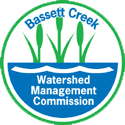News
Watershed Commission Rolls Out Salt Smart Education Campaign
Thu, Dec 5, 2019Watershed Commission Rolls Out Salt Smart Education Campaign
In slippery Minnesota winters, safety is certainly the top concern. But over salting sidewalks and parking lots doesn’t provide extra safety, it just damages property and pollutes water. The Bassett Creek Watershed Management Commission is launching a “Salt Smart” educational campaign (saltsmart.info) aimed at local establishments about how to keep areas safe using the correct amount of salt.
THE PROBLEM
At $223 per ton for the salt, labor, and equipment, applying salt seems relatively inexpensive. However, the hidden costs are enormous. Salt erodes buildings and railings, pits sidewalks, ruins indoor flooring, and damages vegetation. The actual costs of applying a ton of salt are estimated by Fortin Consulting, Inc. to be between $1,000-3,500.
Salt is toxic to Minnesota aquatic life. Just one little teaspoon of salt makes five gallons of water uninhabitable for most freshwater species. Fifty lakes and streams in Minnesota already have salt (or chloride) levels above state standards. And chloride concentrations are above the water quality standards in 30% of the shallow groundwater monitoring wells in the Twin Cities metro area. Since groundwater is widely used as drinking water, this could translate into health and taste concerns too.
When snow and ice melt off hard surfaces, it runs into storm drains that flow into lakes, streams, and wetlands – taking the salt with it. Once the salt is dissolved in water, there is no practical way to get the salt out of the water. While it is possible to desalinate water with massive desalinization plants, how would this work for entire river systems, lakes, and groundwater? And at what cost?
SALT SMART SOLUTION
Just like maintaining good health, prevention is the key. Right now, we are unnecessarily “feeding” our lakes and streams excessive amounts of salt.
FOLLOW THESE “SALT SMART” STEPS
- Promptly remove snow and ice. This is key to preventing ice buildup. Invest in an ice scraper with a 7 to 10-inch blade & 48-inch handle.
- Salt sparingly. The salt granules should be about three inches apart and applied only when pavement temperature (not air temperature) is above 15 degrees Fahrenheit. Use a temperature gun to determine the pavement temperature.
- Sweep up and re-use excess salt.
- Tell others how and why to salt smart by handing out cards that can be picked up at city halls.
GET INVOLVED
Please pick up informational cards from participating city halls to hand out at places you visit in your community. If you are a member of a club, consider picking up extra cards to get your entire group involved. To help us spread this important message, BCWMC is aiming to partner with public, private and nonprofits organizations and clubs: Scouts, Lions/Leos, Kiwanis/Key Club, Rotary, gardening, etc., Humane Society, vet clinics, health clinics, schools, and youth groups.
Distribute the appropriate cards to the places you go. When you visit places that are over salting (salt granules closer than three inches apart), offer an education card on smart salting practices. When you visit places that are practicing the best salting practices listed above (and on the back of the cards), thank them and offer a “WE ARE PROUD TO SALT SMART” card. Suggest that they display the card to help educate others about why they aren’t using the excessive amounts of salt that people have become accustomed to.
BCWMC’s goal is to make smart salting practices the norm to protect our health and recreation.It may be hard to start a conversation about over salting, because we Minnesotans tend to shy away from anything that resembles confrontation. But the health of our future’s water is worth the uncomfortable conversation, isn’t it? Will you help be part of the solution? Please follow us on Facebook and share our posts and hand out cards wherever you go this winter.

